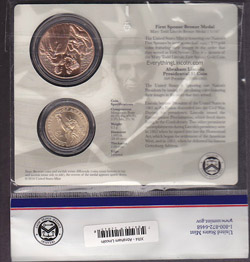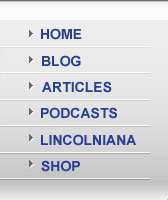Since the commemoration of Abraham Lincoln's 100th birthday in 1909, Lincoln has appeared on many coins, both circulating and commemorative. He appears on circulating currency as well.
State Quarter: Illinois
The U.S. Mint started a successful coin program to commemorate the 50 states in 1999. Four years later, on January 2, 2003, the Illinois quarter was released (463.2 million minted). The 21 stars on the back of the quarter pay tribute to the fact that Illinois was the 21st state admitted to the Union. It is also a forward-looking nod to the future in the 21st Century. The design recognizes the two distinct regions in the state: the rural farmland and cornfields in the state, and the fantastic urban skyline of Chicago.
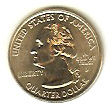
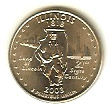
 At the center, of course, the design of the Land of Lincoln quarter honors our great 16th president, Abraham Lincoln.
At the center, of course, the design of the Land of Lincoln quarter honors our great 16th president, Abraham Lincoln.
The coin is the first to depict Lincoln as a young man, showing him at the time he came to New Salem. It is taken from the heroic bronze statue of Lincoln (The Resolute Lincoln) by sculptor Avard Fairbanks, which is at New Salem, Illinois.
Circulating Production:
- Denver Mint: 237,400,000
- Philadelphia Mint: 225,800,000
- Total: 463,200,000
scroll for more about the Illinois quarter
The US Mint created 75,000 limited edition Illinois Official First Day Coin Covers. Priced at $19.95, they were available through the Mint on January 27, 2003. They've since sold out, but are occasionally available on eBay.
The Illinois First Day Coin Cover features two quarters--one from the Philadelphia Mint, and one from Denver--from December 9, 2002, the first day of mintage. The quarters are on a display card that features a 37-cent United States Flag postage stamp. The "January 2, 2003, Lincoln Station, Lincoln, IL 62656" postmark indicates the day Illinois quarters were released to the Federal Reserve Bank and to the public.
National Sites Quarter: Gettysburg, Pennsylvania
Fifty-six sites will be featured as part of the National Sites Quarters Program. The legislation authorizing this series is "America's Beautiful National Parks Quarter Dollar Coin Act of 2008" (Public Law 110-456). The sites had to be selected with 270 days of approval of the legislation. On August 25, 2009, Secretary of the Treasury Timothy F. Geithner approved the list of sites with consultation with Secretary of the Interior Ken Salazar.
One site was selected from each state, the District of Columbia, and each U.S. territory (Puerto Rico, Guam, America Samoa, the U.S. Virgin Islands, and the Northern Mariana Islands). The program runs from 2010 to 2021. Five different designs are released each year, and the final quarter will be released in the last year. The quarters will be issued in the order that the featured sites were established as a National Site. The US Mint's National Site Registry lists all 56 sites to be featured in the series.
The front of the coin will feature a portrait of George Washington. Rather than using the portrait design used by the State Quarters and U.S. Territories series, the portrait on the America the Beautiful Quarters will be the original portrait used on the quarter since the Washington Quarter was released in 1932.
The first quarter release in 2011, was the Gettysburg National Military Park in Pennsylvania. The reverse shows the 72nd Pennsylvania Infantry Monument, on the battle line of the Union Army at Cemetery Ridge. Inscriptions are "GETTYSBURG," "PENNSYLVANIA," "2011," and "E PLURIBUS UNUM."
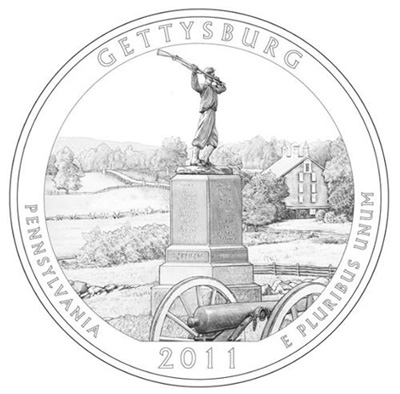
Gettysburg was established to "preserve and protect the resources associated with the Battle of Gettysburg and the Soldiers' National Cemetery, and to provide understanding of the events that occurred [there], within the context of American history." Amending the Act of Congress of February 11, 1895 (An Act to Establish a National Military Park at Gettysburg, Pennsylvania, S 3, 28 Stat. 651, codified as amended at 16 U.S.C. § 430g) Gettysburg was established as a National Site. The legislation was sponsored by General Daniel Sickles of New York, whose military career ended with the loss of a leg at the Battle of Gettysburg. The Act directed the War Department to establish Gettysburg National Military Park by accepting a deed from the Gettysburg Battlefield Memorial Association conveying ownership to over 800 acres and 300 monuments.
Release Date: January 24, 2011
Designer: Joel Iskowitz
Sculptor-Engraver: Phebe Hemphill
Circulating Production:
- Denver Mint: TBD
- Philadelphia Mint: TBD
- Total: TBD
Other design candidates included depictions of a park ranger and a group of tourists near a canon, with the Eternal Light Peace Memorial on Oak Hill in the background. The memorial was dedicated by President Franklin Roosevelt on July 3, 1938--the 75th anniversary of the Battle of Gettysburg.
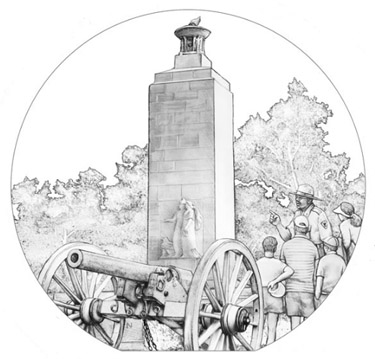
...Soldiers National Monument, sculpted by Randolph Rogers. Statues around the base of the monument symbolize history, war, peace and plenty. A statue of Liberty adorns the top of the monument.
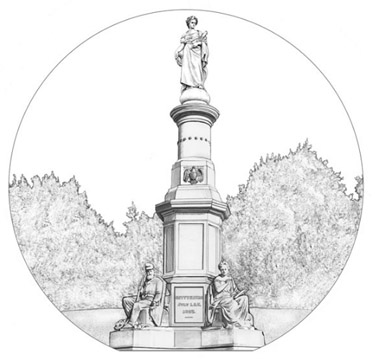
...and a couple at the Lincoln Speech Memorial, a memorial dedicated not to Abraham Lincoln, who is pictured at the center of the memorial (speech plaques are to Lincoln's right as well as to his left), but to Lincoln's speech: the Gettysburg Address.
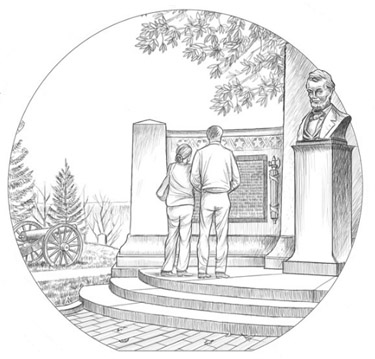
Commemorative Silver Dollar
On February 12, 2009, the U.S. Mint released the Abraham Lincoln Commemorative Silver Dollar.
H.R. 2808, sponsored by Ray LaHood (R-IL), was introduced on June 8, 2005. Its purpose was "to require the Secretary of the Treasury to mint coins in commemoration of the bicentennial of the birth of Abraham Lincoln."
The the house resolution became Public Law 109-285, the "Abraham Lincoln Commemorative Coin Act," signed into law on September 27, 2006. It required the Secretary of the Treasury to mint and issue $1 silver coins in commemoration of Lincoln's 200th birthday, with a mintage maximum of 500,000. The coins are to be sold in 2009 only, in proof and uncirculated condition. The public law also requires a $10 surcharge per coin, to be paid to the Abraham Lincoln Bicentennial Commission to further its work.
The front of the coin depicts an image of Abraham Lincoln, inspired by Daniel Chester French's magnificent sculpture in the Lincoln Memorial. It was designed by United States Mint Artistic Infusion Program Master Designer Justin Kunz and sculpted by United States Mint Sculptor-Engraver Don Everhart.
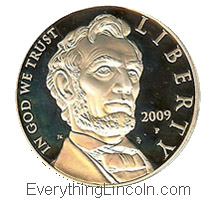
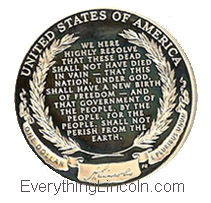
The unveiling ceremony took place at Gettysburg National Cemetery on November 19, 2008, the 145th anniversary of the cemetery's dedication (then called the Soldier's National Cemetery). Of course, that original dedication marked the delivery of Lincoln's Gettysburg Address.
The closing words of the Gettysburg dedication are inscribed on the back of the coin. A laurel wreath encircles the words, and a banner bearing Lincoln's signature is at the bottom center. The back of the Lincoln commemorative silver dollar was designed and sculpted by United States Mint Sculptor-Engraver Phebe Hemphill.
Weight: 26.73 grams
Diameter: 1.500 inches
Composition: 90% silver; 10% copper
The U.S. Mint introduced the proof silver dollar at $37.95 ($41.95 after March 16, 2009) and the uncirculated silver dollar at $31.95 ($33.95 after March 16).
Abraham Lincoln Presidential Dollar
The U.S. Mint announced the new 2010 Presidential Dollar designs on December 8, 2009. A portrait of Abraham Lincoln is on the front of the coin. The inscriptions are "Abraham Lincoln," "In God We Trust," "16th President," and the years of his term in office "1861-1865."
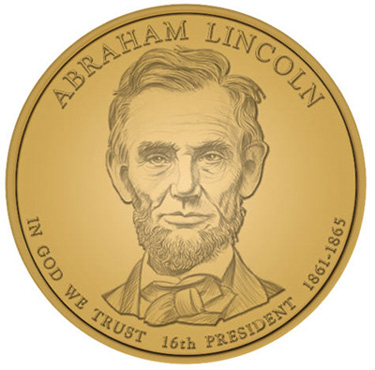
The U.S. Mint began sales of the Abraham Lincoln dollar on November 18, 2010, at $35.95 per roll plus shipping/handling. Rolls of the dollars contain 25 coins and are packaged in specially-designed wrappers. The U.S. Mint logo is on each wrapper, along with the President's name, face value of the roll, and the mint of origin (P [Philadelphia] or D [Denver]).
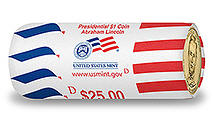
The official launch ceremony for the Abraham Lincoln Presidential Dollar was held the day after the Mint opened sales, on November 19, 2010, at the Lincoln Cottage in Washington, D.C. (The President Lincoln and Soldiers' Home National Monument is officially known as "President Lincoln's Cottage" at the Armed Forces Retirement Home.) The date marked the 147th anniversary of the delivery of the Gettysburg Address. U.S. Mint Director Ed Moy introduced the new dollar during the ceremony.
Designer: Don Everhart
Sculptor-Engraver: Don Everhart
Mr. Everhart is also the sculptor for the 2009 Lincoln cent Professional Life design. The front side of the 2010 Millard Fillmore Presidential Dollar coin is also by Everhart.
Release Date: November 18, 2010 (ceremony November 19)
Ceremony: Washington, D.C.
The obverse is similar to this 1970 African coin: a 75 peseta silver proof from Equatorial Guinea.
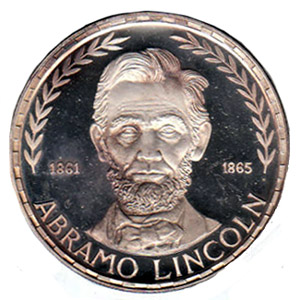
The reverse side of the US 2010 Abraham Lincoln Presidential Dollar coin is the same as all other presidential coins in the series. It features a beautiful image of the Statue of Liberty. Like the front side of the 2010 Lincoln dollar coin, the reverse side of all coins in this series is by U.S. Mint Sculptor-Engraver Don Everhart.
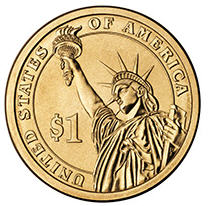
The Presidential $1 Coin Act of 2005 (Public Law 109-145 [PDF file]) required "the Secretary of the Treasury to mint coins in commemoration of each
of the Nation’s past Presidents and their spouses, respectively, to improve circulation
of the $1 coin, to create a new bullion coin, and for other purposes." Several observations are called out in the coin act, including these:
Congress finds the following:
(1) There are sectors of the United States economy,
including public transportation, parking meters, vending
machines, and low-dollar value transactions, in which the use
of a $1 coin is both useful and desirable for keeping costs
and prices down.
(2) For a variety of reasons, the new $1 coin introduced
in 2000 has not been widely sought-after by the public, leading
to higher costs for merchants and thus higher prices for consumers.
(3) The success of the 50 States Commemorative Coin
Program (31 U.S.C. 5112(l)) for circulating quarter dollars
shows that a design on a United States circulating coin that
is regularly changed in a manner similar to the systematic
change in designs in such Program radically increases demand
for the coin, rapidly pulling it through the economy.
(4) The 50 States Commemorative Coin Program also has
been an educational tool, teaching both Americans and visitors
something about each State for which a quarter has been
issued.
(5) A national survey and study by the Government
Accountability Office has indicated that many Americans who
do not seek, or who reject, the new $1 coin for use in commerce
would actively seek the coin if an attractive, educational
rotating design were to be struck on the coin.
It's not clear that the Presidential $1 Coin Act of 2005 has at all been successful in making the dollar coin more attractive to the public for use in circulation--though they certainly are the common currency of city parking lot permit stations that dispense change. Nonetheless, another circulating coin honoring Abraham Lincoln is welcome.
The Abraham Lincoln $1 Coin Cover (envelope) was released (made available for sale) December 31, 2010, by the U.S. Mint. The First Day cover was postmarked at Springfield Station, Springfield, Illinois, on November 18, 2010. It includes two dollar coins (to show front and back, from both Mints) and a 44 cent U.S. Postal Service American Flag stamp.

The front indicates that the first day of mintage in Philadelphia was August 3, 2010, and in Denver was August 2, 2010.
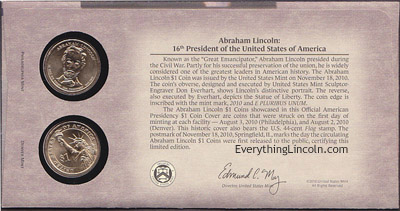
The back has a facsimile of Edmund Moy's signature, director of the United States Mint. The text says:
Abraham Lincoln: 16th President of the United States of America.
Known as the "Great Emancipator," Abraham Lincoln presided during the Civil War. Partly for his successful preservation of the union, he is widely considered one of the greatest leaders in American history. The Abraham Lincoln $1 Coin was issued by the United States Mint on November 18, 2010. The coin's obverse, designed and executed by United States Mint Sculptor-Engraver Don Everhart, shows Lincoln's distinctive portrait. The reverse, also executed by Everhart, depicts the Statue of Liberty. The coin edge is inscribed with the mint mark, 2010 and E PLURIBUS UNUM.
The Abraham Lincoln $1 Coins showcased in this Official American Presidency $1 Coin Cover are coins that were struck on the first day of minting at each facility--August 3, 2010 (Philadelphia), and August 2, 2010 (Denver). This historic cover also bears the U.S. 44-cent Flag stamp. The postmark of November 18, 2010, Springfield, IL, marks the day the circulating Abraham Lincoln $1 Coins were first released to the public, certifying this limited edition.
Mary Todd Lincoln First Spouse Gold Coin and Medal
The final First Spouse gold coin released in 2010, is the Mary Todd Lincoln First Spouse gold coin. A bronze medal, which features the same design as the gold coin but in a slightly larger format, was also available.
A portrait of Mary Todd Lincoln is on the front of the $10 gold coin. The inscriptions are "Mary Todd Lincoln," "In God We Trust," "Liberty," and "16th 1861-1865," indicating that her husband Abraham Lincoln was the 16th President, whose term in office was 1861-1865. The mint mark is "W" for Westpoint.
Release Date: December 2, 2010
Designer: Phebe Hemphill
Sculptor-Engraver: Phebe Hemphill
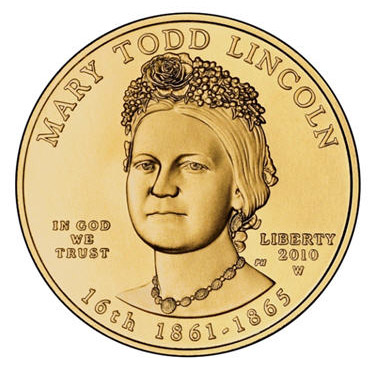
The reverse side of the Mary Todd Lincoln First Spouse gold coin portrays Mrs. Lincoln bringing wounded Union soldiers flowers and books. Inscriptions are "United States of America," "E Pluribus Unum," "$10," "1/2 oz.," and ".9999 Fine Gold."
Designer: Joel Iskowitz
Sculptor-Engraver: Phebe Hemphill
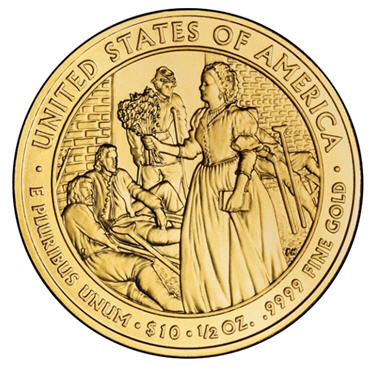
The one-half ounce 24-karat gold coin is produced at the U.S. Mint at West Point in proof and uncirculated qualities. The proof coin with a goldenrod-colored cardboard gift box with sleeve, with the case and coin inside, was $854 from the U.S. mint when the coin first went on sale.
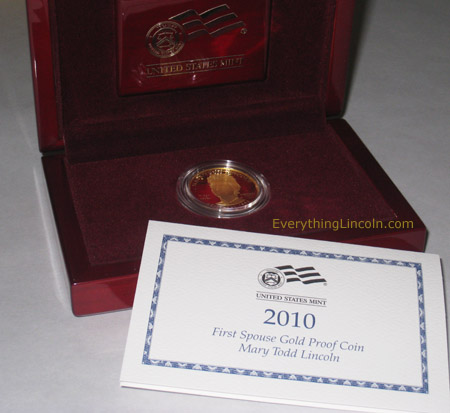
Bronze medals that resemble the gold coin were available from the Mint for $5.50.
The Abraham Lincoln Presidential $1 Coin and First Spouse Medal Set featuring Abraham and Mary Todd Lincoln was released (made available for sale) by the U.S. Mint on December 23, 2010.
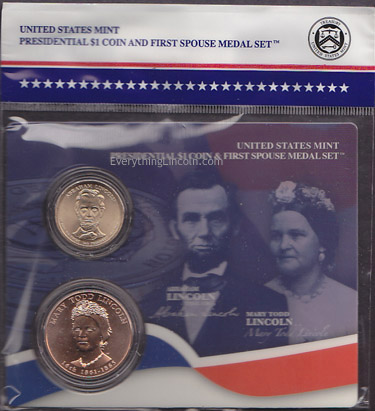
The reverse side of the card indicates an explanatory note about the orientation of the coins: "Because coins and medals rotate differently (coins rotate bottom to top and medals rotate side to side), the reverse of the medal appears upside down." In addition to coin specifications and a brief explanation of the Presidential $1 Coin and First Spouse program, the back also indicates that Abraham Lincoln issued the Emancipation Proclamation to free the slaves in the Confederacy, and notes that "two other prominent accomplishments during Lincoln's presidency" were the signing of the Homestead Act and the delivery of the Gettysburg Address.
